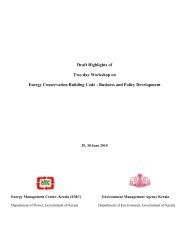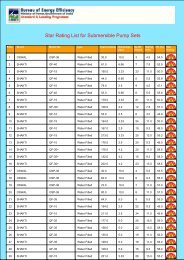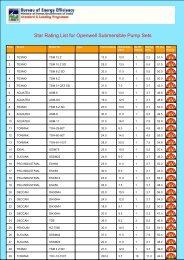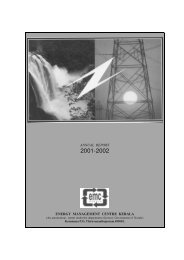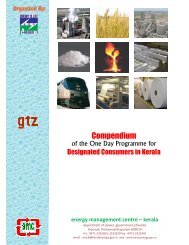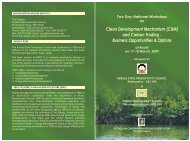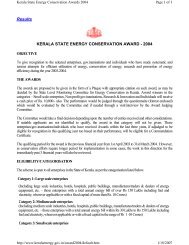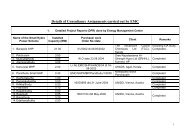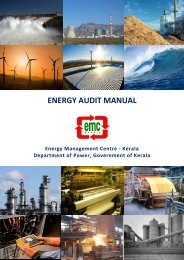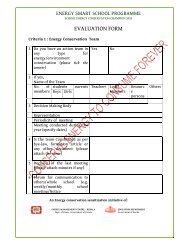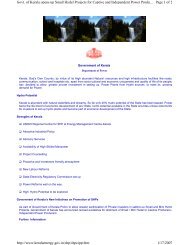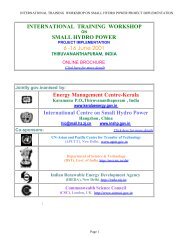energy assessment guide for commercial buildings - ECO-III
energy assessment guide for commercial buildings - ECO-III
energy assessment guide for commercial buildings - ECO-III
You also want an ePaper? Increase the reach of your titles
YUMPU automatically turns print PDFs into web optimized ePapers that Google loves.
ENERGY ASSESSMENT GUIDE FOR COMMERCIAL BUILDINGS<br />
purposes. Physical inspection of the facility is<br />
used to increase familiarity with construction,<br />
equipment, and operation and maintenance.<br />
Anecdotal in<strong>for</strong>mation from interviews of the<br />
owner/operator, staff and occupants can provide<br />
important in<strong>for</strong>mation at this stage.<br />
The analysis of this data will provide basic<br />
in<strong>for</strong>mation on <strong>energy</strong> usage by <strong>energy</strong> source,<br />
consumption patterns and costs <strong>for</strong> total <strong>energy</strong><br />
use and broken down by fuel type. The analysis<br />
of the gathered data will be used by the auditor/<br />
consultant to identify low-cost/no-cost changes to<br />
the facility, operation and maintenance procedures,<br />
and calculate associated cost reductions. As well,<br />
the auditor/ consultant should identify potential<br />
projects or areas of study <strong>for</strong> consideration at<br />
higher level of <strong>assessment</strong>.<br />
3.3 Level II – Comprehensive<br />
Energy Assessment<br />
The purpose of the Level II – Comprehensive<br />
Energy Assessment is to evaluate all <strong>energy</strong><br />
efficiency measures, both capital projects and<br />
changes to operational procedures, that are<br />
available under existing financial constraints. This<br />
level of <strong>assessment</strong> will give a building owner<br />
the in<strong>for</strong>mation that they need to develop a<br />
comprehensive <strong>energy</strong> efficiency program. Any<br />
capital intensive projects that require further<br />
analysis is to be listed and recommended <strong>for</strong> Level<br />
<strong>III</strong>.<br />
The data requirements of a Level II<br />
<strong>assessment</strong> are far more rigorous and require<br />
more time and significant cooperation from the<br />
owner’s staff. This requires a detailed examination<br />
of electrical and mechanical systems including<br />
physical inspection, drawings, building plan<br />
including occupancy details, and operation and<br />
maintenance programs. The auditor/ consultant<br />
also undertakes a system per<strong>for</strong>mance evaluation<br />
of the electrical and mechanical systems based on<br />
design per<strong>for</strong>mance, such as light levels, ambient<br />
air temperature, and humidity, etc. This technical<br />
survey of <strong>energy</strong> using building systems require<br />
the use of measurement and testing equipment.<br />
The analysis is far more comprehensive and<br />
the resulting report should contain significantly<br />
Level II – Comprehensive Energy Assessment - Specific Activities<br />
• Include all specific activities from lower levels<br />
of <strong>assessment</strong><br />
• Review mechanical and electrical system design,<br />
installed condition, utilization, maintenance and<br />
operations<br />
• Review operation and maintenance program<br />
• Measure key operating parameters and compare<br />
to design levels<br />
• Detailed breakdown of <strong>energy</strong> use by end use<br />
component (may require computer simulation)<br />
• List all possible EE modifications to equipment<br />
and operations<br />
• Prioritize in order of likely implementation<br />
• Estimate potential <strong>energy</strong> and cost savings<br />
• Estimate implementation cost<br />
• Estimate combined potential <strong>energy</strong> savings<br />
from all EE measures and financial evaluation<br />
of implementation<br />
• Meet with owner to discuss priorities based on<br />
submission of list of potential EE measures and<br />
select practical measures <strong>for</strong> further analysis<br />
• For each practical measure list:<br />
• Inefficiencies in current practice<br />
• Description of EE measure and effect on<br />
<strong>energy</strong>, health, com<strong>for</strong>t and safety<br />
• Repairs necessary to optimize the EE measure<br />
• Impact on occupant service capabilities<br />
• Impact on operation and maintenance<br />
procedures<br />
21



